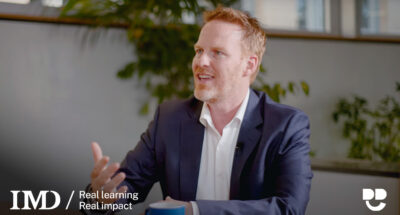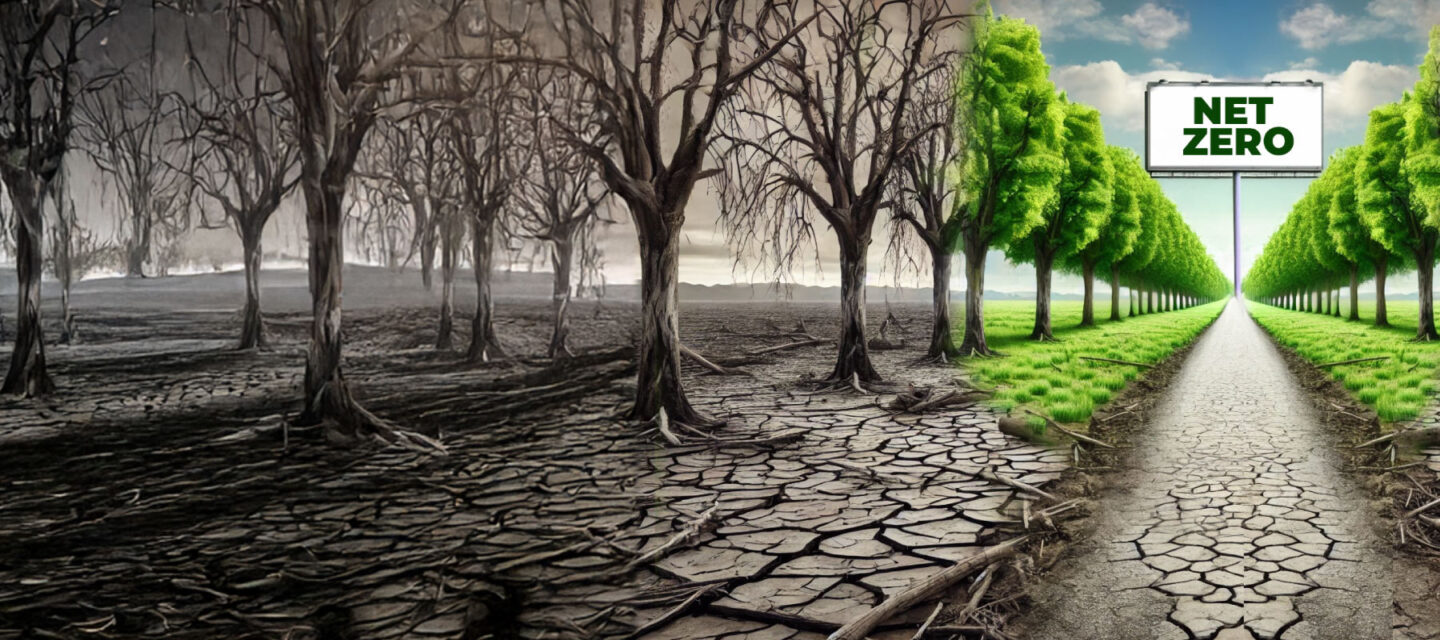
How does sustainable leadership work?
This episode takes you behind the scenes of a recent gathering led by the World Business Council for Sustainable Development together with IMD, where David Bach sat down with two sustainability leaders....

by Heather Cairns-Lee, Ramon de Haas , Meike Kolthof Published October 14, 2024 in Sustainability • 7 min read
As sustainability takes center stage in public discourse, organizations must demonstrate proactive efforts to reduce their carbon footprint. To drive meaningful change, companies need to rally a diverse array of stakeholders – customers, investors, and employees – behind their decarbonization initiatives. The challenge with many decarbonization strategies, however, is that they are often abstract, making them difficult to grasp and fully support.
Heerema Marine Contractors (HMC), which decommissions offshore oil and gas facilities and installs offshore windfarms, set itself the challenge of reducing its greenhouse gas (GHG) emissions to future-proof its operations.
Instead of merely setting ambitious targets without demonstrating technical feasibility, HMC wanted the new strategy to balance ambition with realism, while carefully considering achievable goals. This approach was particularly important given the uncertainties surrounding future technologies, particularly concerning cost-effectiveness and supply chain dependencies.
With a corporate portfolio focusing on installing offshore wind farms and platform decommissioning, HMC’s projects are executed at sea with a fleet of six offshore vessels. Four of these are crane vessels, some of the largest ships available worldwide.
The company’s net-zero ambition, which guides the decarbonization strategy, tends to evoke strong emotions, due to its intersection with a range of ideological views. Colleagues, clients, and the public may perceive it as either overly cautious or too hasty. This emotional charge often arises from differing perspectives on the urgency and feasibility of achieving net-zero GHG emissions.
To succeed in reaching net zero, HMC needed to reconcile these divergent expectations. The company sought to accelerate this change and elevate its communication approach to address its diverse audience, which held different and sometimes opposing views on decarbonization.
As a first step, HMC decided to incorporate some of the principles of John Kotter’s change model, which outlines an eight-step process for leading organizational change. Kotter emphasizes the importance of creating urgency, building a guiding coalition, developing a vision and strategy, communicating the vision, empowering employees, generating short-term wins, consolidating gains, and anchoring innovative approaches in the culture.
The company decided to take a creative approach to steps 3 and 4 of the organizational change process, which deals with developing and communicating a vision and strategy using a cartoon to win employees and stakeholders over to the vision.
Titled ‘Our own course,’ the cartoon is fittingly maritime-themed, in keeping with the company’s work. But it also has personal resonance as the company’s owner, Pieter Heerema, is a sailing enthusiast and owns a boat named ‘No Way Back’.
In the company, everyone knows about this boat. It is a symbol of his commitment and determination to succeed in leading the organization toward meaningful change. The cartoon strengthens this connection, linking decarbonization efforts to the owner’s commitment, affirming that there is ‘no way back’ from the pledge to reduce carbon emissions. The message is clear: “We are all in this together, sailing towards a net-zero future.”
When designing the cartoon, the construction of the visuals was important to ensure the metaphors used represented familiar concepts that would be interpreted easily by the target audience. Here are a few examples of how this works:
The literal dot on the horizon represents HMC’s company-wide commitment to achieving net-zero greenhouse gases by 2050. The fleet sails away from its previous ambition and navigates towards this new direction in which the firm is heading. The movement of the water shows the ability to adapt.
The cartoon shows how all efforts connect with the net-zero commitment and how different projects (symbolized by buoys) help the company reach its long-term goals. It also carries the message that Heerema is sailing its own path with ambition and realism, not just copying others’ targets.
The buoys stand for identified future emission reduction technologies and initiatives. The buoys with flags show successful decarbonization projects so far and celebrate the firm’s progress. They also mark various paths to the target, which is important as the technologies needed to reach the goal are still unknown. It is a way of saying: “We know where we want to go, but we’re still figuring out the best way to get there.”
The cartoon depicts fleet and office staff and different generations working together towards the common goal of decarbonization. The visual metaphors help to bring an abstract and complex subject matter to life, enabling the company to convey its Net-Zero agenda by implying rather than explicitly stating it, in appreciation of the range of opinions on this matter.
Emotions play a crucial role in decision-making, thereby enhancing the persuasive power of the message, and images evoke emotions more effectively than words alone. HMC is proud of its engaged workforce, which has a passion for the equipment it works with. The image of the installation vessels setting course towards an ambitious target connects with colleagues on an emotional level, making the message more compelling and memorable.
Decarbonizing the fleet depends on many fast-changing factors, including technology, infrastructure, politics, and cost, so it is hard to know which solutions will work best. The cartoon helps turn complex information into easy-to-understand visuals, making abstract ideas more real and helping to explain how separate initiatives support a common goal.
The power of the metaphors used in the cartoon lies in their familiarity – seeing boats sailing towards the horizon is much easier to understand than an abstract term like ‘decarbonization.’
There are multiple benefits of using cartoons to communicate a key strategic directive. Visual metaphors have a strong persuasive effect, in part due to their impact on cognitive processing. The cartoon leverages the brain’s ability to process images faster than text. This makes the net-zero ambition more accessible and easier to understand.
Initially, the decarbonization strategy was an extensive, highly technical report of 70 pages. It was a valuable body of work, but not fit as a communication tool. The cartoon has enabled HMC to accelerate alignment on the strategy, engage decision-makers from the start, improve clarity and buy-in from the board of directors, non-executives, and key employees, and create ownership within teams. It has also enabled the firm’s sustainability experts to become aware of the opposing viewpoints within the organization.
The power of the metaphors used in the cartoon lies in their familiarity – seeing boats sailing towards the horizon is much easier to understand than an abstract term like ‘decarbonization.’ The metaphors bring to life how colleagues can help meet the decarbonization goals. Through visual storytelling, the company has effectively shared complex ideas, helping people understand and support net-zero initiatives. This includes reaching those who do not immediately connect with the initiative’s ambition.
The goal of this visual story is to build a “coalition of the willing” – a group of people who are inspired by the message and motivated to act on it. The cartoon helps HMC make the most impact with its message by improving understanding of the strategy and roadmap. It conveys the message on multiple levels, surpassing the capabilities of written communication alone.

Affiliate Professor of Leadership and Communication
Heather Cairns-Lee is Affiliate Professor of Leadership and Communication at IMD. She is a member of IMD’s Equity, Inclusion and Diversity Council and an experienced executive coach. She works to develop reflective and responsible leaders and caring inclusive cultures in organizations and society.

CTO & CHRO at Heerema Marine Contractors
Ramon de Haas, CTO & CHRO, has 27 years of experience at Heerema Marine Contractors in various leading and strategic roles. He drives innovation and organizational transformation, blending performance with experimentation to drive a resilient, future-proof culture rooted in iterative learning and collaborative problem-solving.

Manager Sustainability at Heerema Marine Contractors
Meike Kolthof is Manager Sustainability at Heerema Marine Contractors. With her background in Design Engineering and Innovation Management, she is driven to create positive change within organizations. At Heerema, she developed the current sustainability strategy, of which the net-zero ambition is a part.

April 17, 2025 • by David Bach, Felix Zeltner in Sustainability
This episode takes you behind the scenes of a recent gathering led by the World Business Council for Sustainable Development together with IMD, where David Bach sat down with two sustainability leaders....

April 16, 2025 • by Benoit F. Leleux in Sustainability
How a private equity-backed corporate carve-out created a successful, sustainable consulting powerhouse...

April 14, 2025 • by Salvatore Cantale, Frederikke Due Olsen in Sustainability
By managing ESG-heavy assets separately, companies can drive progress in their sustainable business units while addressing the sustainability challenges of traditional assets. Here are four effective strategies to achieve your goals....
 Audio available
Audio available
April 8, 2025 • by Andrew J. Hoffman in Sustainability
Business schools must cultivate leaders who see beyond profits and embrace business as a powerful force for societal good....
Explore first person business intelligence from top minds curated for a global executive audience